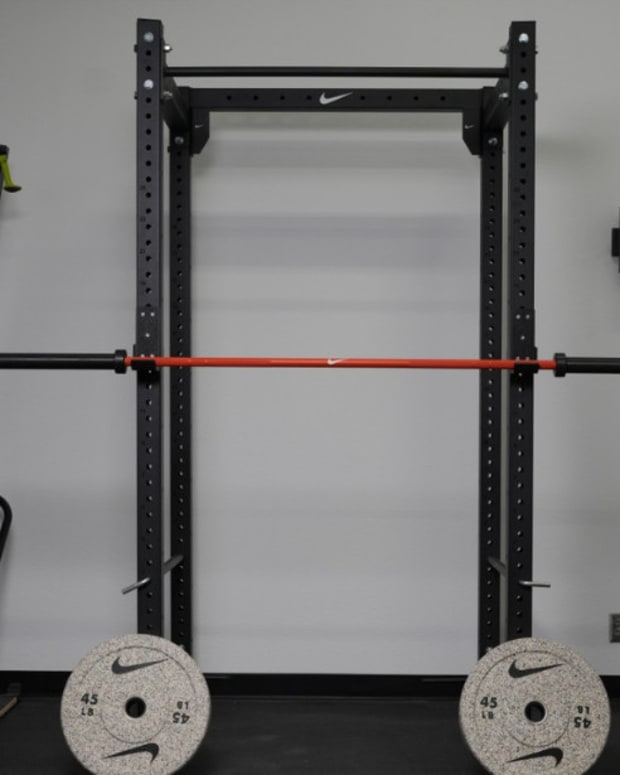The products featured in this article have been independently reviewed. When you buy something through the retail links on this page, we may earn commission at no cost to you, the reader. The Sports Illustrated editorial team is not involved in the creation of this content. Learn more here.
Running versus walking? It shouldn’t be an either/or. These two activities offer similar benefits for your physical and mental health—the degree to which will mostly depend on your goals, your current fitness level and the intensity at which you want to exercise. Running, which inherently requires more energy, is generally more efficient, meaning it’s going to do more for you (and your body) in less time. But a regular walking habit can also significantly improve your overall health and longevity, while being more accessible and less taxing on your body.
Curious as to how these two forms of exercise can seem so different and yet share so many benefits? Read on to find out the specific perks to each activity, which one is better for certain goals (whether that’s weight loss or heart health) and how different variables (like hills and weighted vests) can change the effects of the workout.
Benefits of Walking
Walking is so much more than a way to get from point A to point B. In fact, for every 2,000 steps you take each day, your risk for premature death may fall by eight to 11 percent, according to research published in JAMA Internal Medicine in September 2022. And there are a slew of more specific physical benefits that come from walking: It can help you maintain a healthy weight and lose body fat; prevent or manage various conditions, including heart disease, stroke, high blood pressure, cancer and type 2 diabetes; improve cardiovascular fitness; strengthen your bones and muscles; improve muscle endurance; and improve your balance and coordination, according to the MayoClinic. The faster, farther and more frequently you walk, the better.
But the benefits of walking aren’t just physical. Just 30 minutes of walking per day can reduce symptoms of depression, research in the American Journal of Preventive Medicine determined; studies also show it can improve self-esteem and reduce stress and anxiety. Walking up and down stairs was shown to be more effective at boosting energy than grabbing a cup of coffee in a study published in the journal Physiology & Behavior. And, walking can improve your cognitive function and memory, according to a study from the journal NeuroImage.
Benefits of Running
Since running is basically a more intense version of walking, it shouldn’t come as a surprise to hear that the two activities share a lot of benefits. Runners had a 30 percent lower risk of death from any cause and a 45 percent lower risk of death from heart disease than non-runners, according to a study published in the Journal of the American College of Cardiology. It can also help you lose weight, not just because the average 140-pound person burns approximately 13.2 calories per minute, according to the American Council of Exercise, but because they continue burning an elevated number of calories post-run (that’s called the afterburn effect, and it lasted five minutes longer for runners than it did for walkers in a study published in the The Journal of Strength & Conditioning Research). Running also strengthens your muscles, joints and bones, thanks to that repetitive impact.
And, again, there are the non-physical benefits: Running for two weeks reduced symptoms of depression in a study published in the journal Cortex; even a 10-minute session on the treadmill was shown to improve someone’s mood, research in Nature found. When researchers compared the mental health of runners and non-runners, they found that runners had lower stress and greater psychological well-being, according to a review published in the International Journal of Environmental Research and Public Health. Just 15 minutes of running improves memory, a study in the journal Psychological Reports reported, and it can make you more cognitively flexible, meaning you can adapt and switch gears more easily, according to research in Frontiers in Human Neuroscience.
Related Post: The Best Running Watches for Long Distance, Trail Running and More
Which Is Better for Weight Loss: Walking or Running?
Weight loss is a numbers game—meaning you have to burn more calories than you consume—so from that perspective, running is more efficient than walking. On average, running a mile on the treadmill burned 33 more calories than walking, a study in Medicine & Science in Sports & Exercise found. And calories burned through running led to 90 percent more weight loss than calories burned through walking in another study published in the same journal.
There’s no shortcut for weight loss, though. Losing weight through walking or running takes time, and will eventually require new challenges—increasing the duration of your walk or run, increasing the speed at which you walk or run or adding hills or weight while walking or running—so that you don’t plateau.
Related Post: The Best Running Shoes
Which Is Better for Burning Belly Fat: Walking or Running?
Neither running nor walking can spot-reduce a specific area of fat, but a systematic review and meta-analysis published in PLoS One found that all types of aerobic exercise reduced belly fat, and moderate- to high-intensity workouts were most effective. Walking is generally considered a low-intensity activity (although it could be moderate), while running is moderate- to high-intensity exercise. But women with obesity who walked for 50 to 70 minutes three times a week did reduce their waist circumference and body fat over the course of 12 weeks in a study published in the Journal of Exercise Nutrition & Biochemistry.
Related Post: The Best Walking Shoes for You: Here’s How to Find Them
Which Is Better for Heart Health: Walking or Running?
Walking briskly can lower your risk of high blood pressure, high cholesterol and diabetes—all factors in heart health—as much as running can, research from the American Heart Association found. Over the course of six years, the study authors found that walkers and runners experienced reductions in heart disease risk, but walking actually led to greater impacts on blood pressure and cholesterol.
To reduce risk of many chronic diseases, the Physical Activity Guidelines for Americans, which were updating by the government in 2018, recommend that the weekly exercise time for adults adds up to 150 minutes of moderate aerobic activity (think: walking), 75 minutes of vigorous aerobic activity a week (think: running), or some combination of the two. Both activities absolutely contribute to better heart health.
Which Is Better for Joints: Walking or Running?
Both running and walking are weight-bearing exercises that put stress on your bones, which helps make them stronger. But running involves a lot of repetitive impact, which can do a number on your joints and muscles. Case in point: A 10-minute mile consists of 1,700 steps, and each one of those produces ground reaction forces of about two and a half times your body weight. That’s not great on your joints, but it’s not necessarily correlated to joint damage. For example, researchers found that recreational running will not ruin your knees, a study in Arthritis Care & Research reported.
Walking involves significantly less impact—ground reaction forces are around 1.2 times your body weight—which is generally better for your joints. This kind of low-intensity activity is actually recommended for people with arthritis because it helps to keep the joints flexible. However, you can ease the impact of running by switching up the surface you run on: gravel, dirt and rubber tracks will be more forgiving on your joints.
Walking vs. Running On An Incline
Both running and walking are more challenging on an incline because you’re working against gravity and because more muscles are activated. There’s a unit scientists use to measure the amount of energy the body uses during physical activity, and it’s called a MET (that stands for “metabolic equivalent for task”; you may have seen this on a treadmill). Walking uses three to six METs, while running ranges from six to 23 METs. Walking at a 2.9 to 3.5 mile per hour pace on a one to five percent grade ups the METs to 5.3, while maintaining that pace on a six to 15 percent grade increases the METs to 8.0. Meanwhile, running at a five mile per hour pace (that’s a 12-minute mile) uses 8.3 METs, and that number will go up as your intensity increases.
Uphill walking and running do involve different biomechanical variables (i.e. your body moves a little differently with each activity), according to research published in the European Journal of Applied Physiology. Running on a two to seven percent incline increased heart rate by almost 10 percent when compared with running on a flat surface, a study published in PLoS One found; walking on an incline will also increase your heart rate, although not as much as running. While running tends to build more strength than walking, there are strength benefits to walking against gravity as well. Incline walking helped increase lower body strength without putting the knee joint under too much stress, a study published in Gait and Posture determined, and strengthened the peroneal muscles (which stretch up the side of your leg) and helped people with weak ankles, according to a study in the Journal of Foot and Ankle Research.
Speed Walking vs. Running
Speed walking (AKA power walking) generally means you’re walking at a pace of four to 5.5 miles per hour (that’s a 13- to 15-minute mile). In maintaining that pace, you’re using around 5.0 to 8.3 METs. Running at four miles per hour (a 15-minute mile) uses 6.0 METs, while running at running 5.2 miles per hour (an 11.5-minute mile) uses 9.0 METs.
Typically, you’re moving faster when you’re running than when you’re walking (even speed walking); the more intense your workout, the more calories you’ll burn. But you can see that even when you’re speed walking and running at the same pace—like four miles per hour—you’re going to use more METs while running. That’s because walking requires having one foot on the ground at all times while running is essentially a series of one-legged hops, which again leads to more energy expenditure.
Weighted Vest Walking vs. Running
Carrying extra weight in any capacity forces the body to work harder, which will increase the amount of calories burned. Wearing a 15-pound weighted vest might use approximately 5.0 METs, compared to running at four miles per hour, which uses 6.0 METs. Using a weighted vest that’s 10 percent of your body mass can increase both the metabolic costs—AKA calorie burn—and relative exercise intensity of treadmill walking, a study by the American Council on Exercise found. It will give you more bang for your buck during a walk, but it won’t be as intense as an easy run.
Walking vs. Running FAQs
Is it better to run for 20 minutes or walk for an hour?
Fifteen minutes of walking was shown to be as beneficial as five minutes of running in a study published in the Journal of the American College of Cardiology. By that math, running for 20 minutes is about equivalent to an hour of walking. However, the study pointed out, higher-intensity exercise (i.e. running) yields more favorable effects on mortality and disease risk than lower-intensity exercise (i.e. walking)—and it’s a lot easier to find 20 minutes in your schedule for a run than an hour for a walk. And running does burn more calories than walking, but it is more taxing on your body. If you’re struggling to find the motivation to run, using a running app with daily goals and community challenges can help.
Is walking everyday enough exercise?
Daily walks are a great form of exercise. You should aim for 150 minutes of moderate aerobic activity and 75 minutes of vigorous aerobic activity a week, per the Physical Activity Guidelines for Americans. Unless you’re walking at a very brisk pace, you may need to include more vigorous activity a few times a week.
Is it better to walk or run for 30 minutes?
This depends on what you want to get out of your activity. Walking for 30 minutes has a number of health benefits, but if you’re looking to burn more calories or improve your fitness, running for a half an hour will have a bigger payoff than walking for the same duration.
Is it okay to run everyday?
This will depend on your fitness level and history. Some people do run every day, and they’re totally fine. Other people need multiple rest days per week. Running five to 10 minutes every day at a moderate pace resulted in improved cardiovascular health, lower blood pressure and reduced risk of all-cause mortality in a study published in Progress in Cardiovascular Diseases. Short runs like that can be great, but if you’re running for extended periods of time or running intensely, you should incorporate at least one recovery day per week.
Final Thoughts
Both running and walking can help you maintain a healthy weight and lose weight; stave off certain health issues; improve your cardiovascular health; boost your mood and energy levels; reduce depression, stress and anxiety; and increase your brain function. Walking is gentler on your body, but it will take more time to reap the rewards; running, which requires more energy, can deliver those health benefits more efficiently—even in just five to 10 minutes per day. The goal is to get at least 150 minutes of moderate cardio exercise per week. Any kind of combination of these two activities is a great way to take charge of your physical and mental health.
Prices are accurate and items in stock as of publish time.












